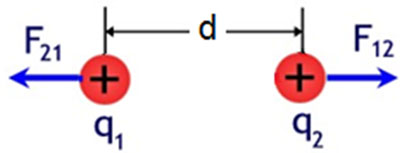
Adapted from: Opposites Attract, Don Bahls, University of Alaska - David Newman

Adapted from: Opposites Attract, Don Bahls, University of Alaska - David Newman
Two charges q1 and q2, are separated by a distance d. The magnitude of q1 is 5 × 10 -6C, the magnitude of q2 is 4 × 10 -6C, and the distance between the two charges, d, is 0.5 m. Determine the magnitude of the electric force between q1 and q2.


An electric force F exists between two positive charges q1 and q2. If the distance between the two positive charges is increased to 3 times the original distance d, what is the new electric force F' between the two charges? Express your answer in terms of the original electric force F.
